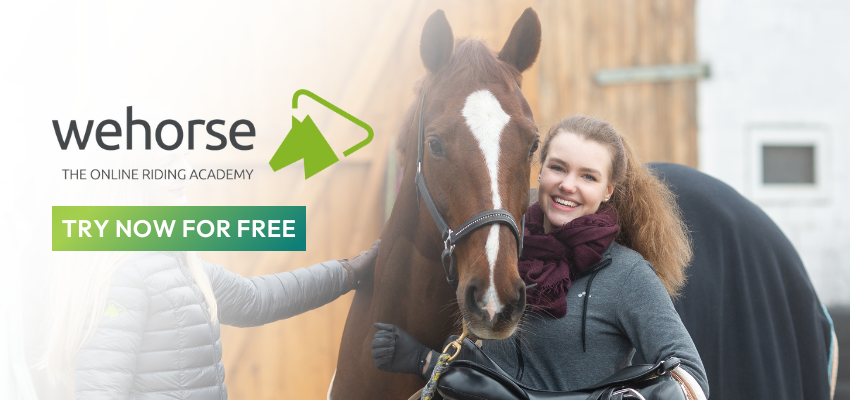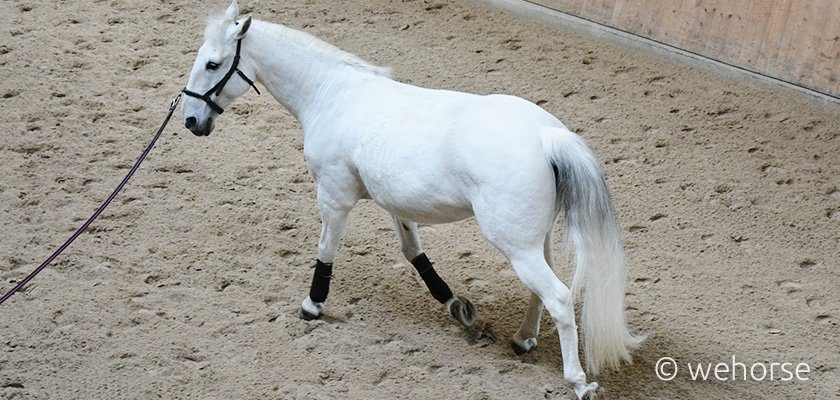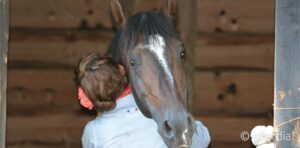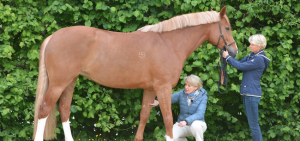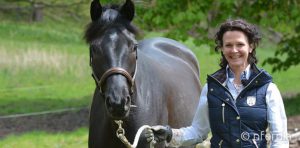Every horse is born unbalanced. If things go wrong on their own in the pasture, the horse can usually figure it out. However, when the rider’s weight is added, it can throw the horse off balance. It is important that the horse learns to use its body in a way that distributes the load evenly. This is where straightness comes into play.
Table of Contents:
- The horse’s natural crookedness
- What do “hollow side” and “stiff side” mean in horses?
- Anja Beran’s correction of crookedness
- How to recognize a horse that is hollow to one side
- What to do about the horse’s natural crookedness
- What if the horse falls in on the right shoulder?
- How to properly straighten your horse
Anyone who rides needs straightness
Ultimately, without straightening, the rider risks wear and tear to their horse. Dressage trainer Anja Beran explains in her wehorse course how to recognize which crookedness is present in your own horse and which exercises help to straighten it depending on the crookedness.
The horse’s natural crookedness
What horse crookedness is and why it is a problem when riding: Horses do not naturally carry their own weight evenly over all four limbs. A nice mental picture of this from dressage trainer Jan Nivelle: The untrained horse resembles a building on four pillars. Two of the legs (pillars) are positioned to support the roof, one leg juts out so that it hardly supports any weight, and the fourth leg is offset so much that it bears the brunt. However, if you want to add stories to the house, the pillars (legs) must be straight under each corner of the roof, otherwise, the weight will be too heavy.
Right turn
In most cases, the untrained horse carries most of the load on the right front. Because of this, most horses find it easier to bend to the left. If you want to ride and don’t want to risk the horse being damaged by the rider’s weight, you have to train it so that it becomes even on all sides: it has to carry the weight on all four legs and bend to both sides. In order to achieve the arc of tension, the horse must be able to lift its core and diligently step under it. Exception: There are also horses that do not have a significantly worse side. Depending on how the horse is worked, the crookedness can switch from one side to the other. However, the goal of straightness and lifting the core remains the same for all horses.
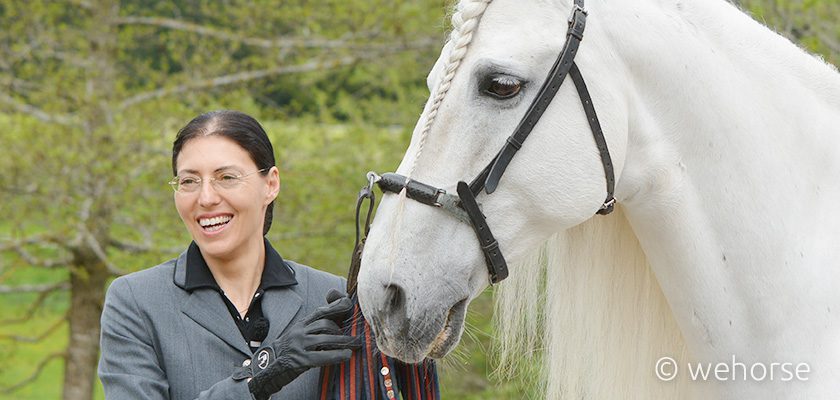
What does “hollow side” mean in horses?
The hollow side is the side that the horse particularly likes to bend. The musculature of this side is shortened. The ends of the horse’s body tend to point to the left, and in extreme cases, the shape resembles a banana bent to the left. The horse pushes itself onto the outside shoulder, so it pushes outwards on the left over the shoulder.
What does “stiff side” mean in horses?
The stiff side is the side to which the horse is less inclined to bend. The musculature is less shortened here, but in contrast to the hollow side, it even allows it to bend, so it is stretched more in the natural movement sequence. The front leg on the stiff side is always loaded more because the horse is pushing onto the shoulder on the stiff side.
Anja Beran’s correction of crookedness with straightness
Classical Dressage trainer Anja Beran gave a lecture on natural crookedness and showed what you can do about it during training. The horse she used for the demonstration is called Generale Cassa. He is 13 years old and a typical left-hollow horse.
Lunging without auxiliary reins
To show which side the horse is stiff, she uses a lunge line with cavesson. On the left rein, Generale Cassa tries to make himself hollow inwards, i.e. to the left. Lunged on the left hand, he likes to look inwards and press outwards over his shoulder. That’s how he likes to move freely, the trainer explains, as if the ends of the horse’s body were constantly pressing to the left. This makes maintaining a correct circle line difficult on the lunge and when riding, as the horse pushes outward over the shoulder.
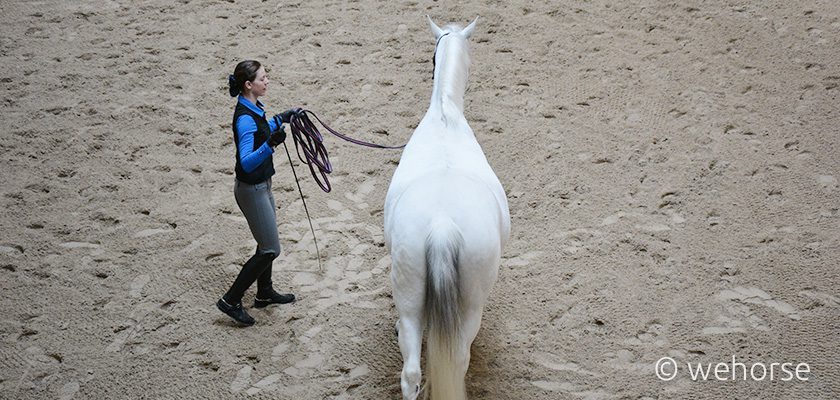
How do I recognize a horse that is hollow on the left?
This horse tries to absorb the centrifugal forces in a curved line with the right front leg and the left hind leg. The rider gets the impression that the horse is heavy in the right shoulder or is pushing towards it. The left shoulder is freer and the left front leg bears less load. The selected head and neck position is typical: the horse, which is hollow on the left, tends to take the head to the left as a control element, the eye muscles also adjust to this, as do the nostrils. This means: It looks more to the left, and eyes and nostrils point in that direction. A horse that is hollow on the left tends to push inwards when lunging on the right hand. It looks outwards. On the left rein, it leans outwards. It looks inward. So it follows the shoulder or the front leg.
How do I recognize a horse that is hollow on the right?
The horse that is hollow on the right likes to lead its head and hips to the right. The musculature of the right side is shortened. It supports itself on the left front leg. The horse’s left shoulder appears heavy to the rider, this is the shoulder towards which it is pushing. The inside hind leg can be pushed under a little if the crookedness is pronounced. Such a horse tends to look more to the right on the lunge.
What to do about the horse’s natural crookedness?
Straightness is central to horse training and the scale of training. This is exactly what protects the horse from being damaged by riding on the more heavily-loaded leg. In the course, Anja Beran shows exactly which exercises are useful for which crookedness is on the way to straightening. For Generale Cassa, for example, giving way to the left leg is helpful – “That’s our first means of riding the horse away from the right shoulder!” explains Anja Beran. The horse must step away from the rider’s right thigh. The rider has the chance to give in with his right hand again and again, explains the dressage trainer. The leg yield is first used along the rail, then also on the diagonal. Stepping to the left encourages straightness.
On the right rein, a shoulder-in is particularly helpful for the horse. The videos explain in detail which other exercises, which are logically built on top of each other, help with straightening. Travers, traversals, and haunches-in are used in the walk and linked in their sequence. Instructor Anja Beran explains the gymnastic value of the exercises. She also explains which exercises are helpful in which order in the trot and canter.
What to do if the horse falls in on the shoulder
It is important not to rely on the arena rails or riding track. Pay attention to which shoulder your horse is falling in on and then consciously shift your weight to the other shoulder or into balance.
For example, if your horse tends to fall on its right shoulder, it will help you to turn your left leg and ride in an outside position. Shoulder-in and stepping over will help you on the right rein. This way you will be better able to take the excess weight off the right shoulder and let your horse step towards the left shoulder.
The outside position is helpful
The outward position is also a recipe that is used in a targeted manner in Anja Beran’s course on straightness. On the left-hand circle, the gray gelding wants to make himself too hollow – using the outside position then helps to straighten the forehand and shoulders again and bring them in front of the hindquarters.
How do I properly straighten my horse?
Every horse has a natural crookedness; we now know that. The side to which it naturally bends more is the hollow side, and the one that tends to stretch as a result is the constrained or stiff side.
The most important information on straightness for quick reference:
- Start with the good side of the horse.
- Make the horse supple through transitions and let them step over.
- Make sure that you push with the inner thigh against the steady outer hand in these exercise sequences.
- On the forced side, make sure the horse doesn’t use the inside hand for support.
- To prevent this, transitions on the short side or volts, for example, which are connected to the open side of the circle, can help.
- Excellent Practice: The Figure-Eight. This figure-eight can be imagined as two volts attached to one another. The figure corresponds to the change from the circle, but it is not specified where it is ridden and how big. From an eight-meter volte to the size of a circle, everything is conceivable depending on the level of training. The smaller the circle, the more difficult it is for the horse and its balance!
You can find versatile exercises and helpful tips for the straightening of your horse on our website.
